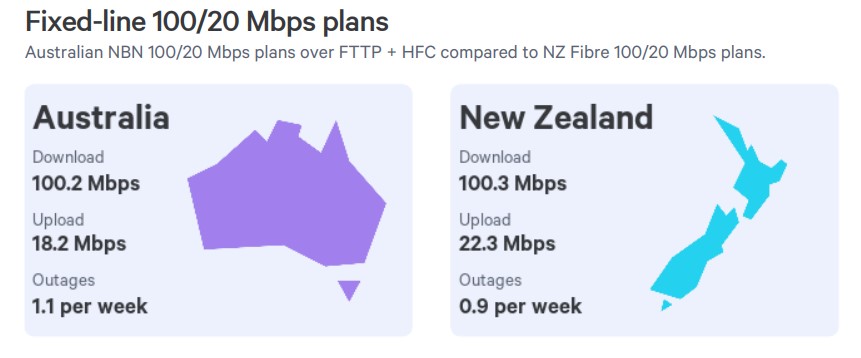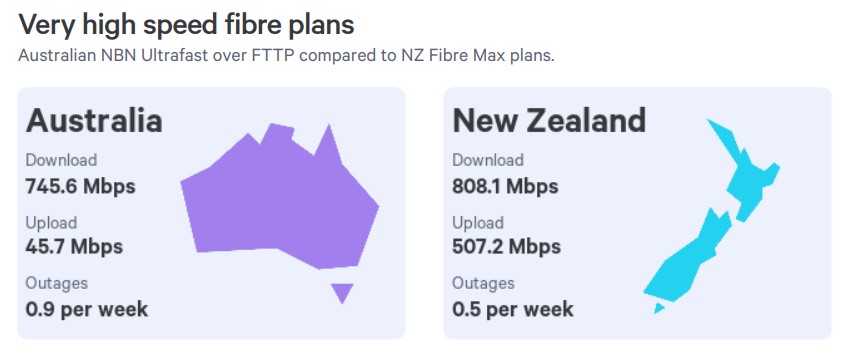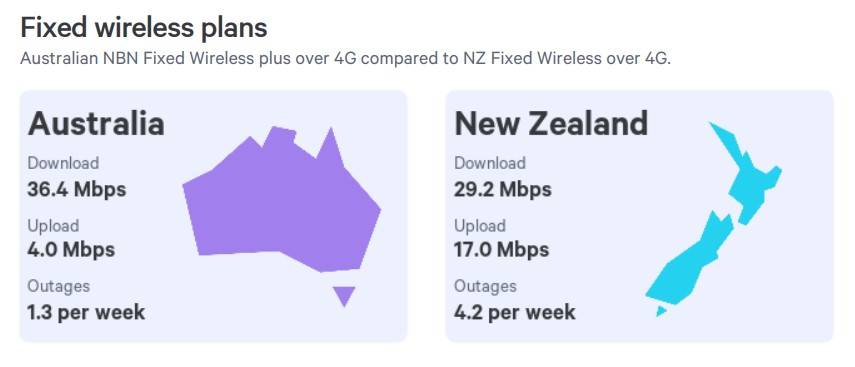The Australian Competition and Consumer Commission (ACCC) has released a new report that pits Australian broadband speeds and performance against New Zealand’s fibre and fixed wireless networks, to see just how the NBN stacks up. And while Australia’s broadband network offers respectable download speeds, the data shows that when it comes to uploads Kiwis are leaving us in the dust.
Released in partnership with the New Zealand Commerce Commission (NZCC), the ACCC’s report analyses data taken from Australia’s ongoing Measuring Broadband Australia program, and from Measuring Broadband New Zealand across the Tasman. The findings are based on data collected throughout September 2021, with fixed-line 100/20Mbps plans, very high speed fibre plans, and fixed wireless plans all directly compared.
Australia’s NBN vs New Zealand’s UFB
While Australia’s results are based on NBN connections, the New Zealand equivalent is the Ultra-Fast Broadband initiative or UFB, which is a New Zealand Government program that delivers fast broadband to consumers over a range of technologies including fibre, fixed wireless, hybrid fibre coaxial (HFC), and in some cases ADSL and VDSL. As of September 2021, close to 1.2 million premises were connected to the UFB via fibre, with 67% on 100Mbps connections and 19% on ultra-fast Fibre Max connections of up to 1000Mbps.
In Australia, around 1.6 million homes and businesses were on the NBN’s Fibre to the Premises (FTTP) connections, and 2 million on HFC as of September 2021. 18 per cent of combined FTTP and HFC customers were on 100Mbps (NBN 100/20) plans, and 2.4% were on 1000Mbps (Home Ultrafast).
Fixed-line 100/20 Mbps plans compared (NBN 100)

When it comes to the more-common 100Mbps download speed tier, Australia and New Zealand are mostly neck-and-neck. Outside of busy hours the average download speed in Australia is 102.1Mps, which is slightly faster than New Zealand’s average of 101.2Mbps. The average Australian speed during the 7pm-11pm peak period is 100.2Mbps, with an average of 100.3Mbps in New Zealand.
Both Australia and New Zealand will over-provision download speeds, so performances over 100Mbps are common. Over-provisioning in Australia is set by NBN Co, while in New Zealand this is controlled by individual internet providers.
While NBN Co only over-provisions downlinks, New Zealand providers allow extra speed for both downloads and uploads. The average upload speed on Australian NBN 100/20 plans is 18.3Mbps, and 18.2Mbps during peak traffic hours. In comparison, New Zealand customers average upload speeds of 22.4Mbps outside of busy hours, and 22.3Mbps during the high traffic period.
Very fast 1000Mbps plans compared (NBN 1000)

While results for 100Mbps are more or less similar in both countries, looking at ultra-fast, gigabit-speed fibre connections highlights a clear gap, particularly in upload capabilities.
In Australia, customers on Home Ultrafast NBN connection achieved an average download speed of 804.Mbps outside of busy hours, and a significantly-lower busy hours average of 745.6Mbps. New Zealand’s Fibre Max customers fared better, with an average download speed of 851.1Mbps outside peak hours, and 808.1Mbps during the busy evening period.
The ACCC also noted that the proportion of customers with average download speeds higher than 900Mbps is greater on New Zealand’s Fibre Max plans when compared to NBN, despite both connections offering a maximum potential speed of 1000Mbps. Australians also experience a bigger difference between peak and off-peak download speeds, meaning that Ultrafast NBN is more noticeably impacted by congestion than its New Zealand equivalent.
While both Australia and New Zealand offer a maximum possible download speed of up to 1000Mbps on very high speed fibre plans, Australia caps upload speeds at 50Mbps. However, New Zealand Fibre Max plans can offer average upload speeds of 400Mbps or more, and it’s this figure that is advertised to customers.
During the September 2021 testing period, the average off-peak upload speed for Australian Ultrafast NBN was 46Mbps, with a busy hour average of 45.7Mbps. But in New Zealand, customers on very fast fibre plans experienced average an upload of 508.9Mbps outside of busy hours, and 507.2Mbps during the peak evening period.
Fixed wireless speeds compared (NBN Fixed Wireless Plus)

The ACCC and NZCC also compared fixed wireless speeds in September 2021, collecting performance data for Australian NBN Fixed Wireless Plus plans and New Zealand’s similar 4G fixed wireless service. There are no specified average speeds for these plans, although Australian fixed wireless plus users can expect a potential maximum speed of up to 75Mbps down and 10Mbps up.
The average speeds recorded in the ACC’s report were decidedly lower, with NBN Fixed Wireless Plus customers experiencing an off-peak average download speed of 47.6Mbps, and on-peak average of 36.4Mbps. However, this was markedly faster than the New Zealand average: during off-peak periods, 4G wireless delivered an average download speed of 39.1Mbps, and dropped to an average of 29.2Mbps during busy hours.
Both countries showed a drop in speed of around 10Mbps between busy and not-so-busy hours, indicating that high demand causes a significant fall in download performance across both technologies.
Upload speeds for Australian Fixed Wireless Plus plans clocked an average of 5.3Mbps outside busy hours, and 4Mbps in peak traffic. In New Zealand, 4G fixed wireless upload speeds averaged 18Mbps in off-peak hours, and 17Mbps during busy periods.
ACCC: slow uploads and busy hour drops highlight NBN weaknesses
Overall, the ACCC found that while download speeds on most Australian plans are comparable to New Zealand, upload speeds — and the gap between on-peak and off-peak traffic performance — falls comparatively short.
“By benchmarking Australia’s high-speed broadband performance against other countries, we can assess the relative strengths and weaknesses of the NBN,” said ACCC Commissioner Anna Brakey.
“The NBN generally compares well to equivalent connection types in New Zealand, particularly download speeds during the day. However, NBN’s access charging model and approach to provisioning upload traffic on fixed-line connections appear to be causing some busy hour and upload metrics to fall below New Zealand’s.
“There are no technical impediments to the NBN matching New Zealand’s busy hour and upload performance on 100 Mbps download plans.”
Australian customers wanting better upload speeds do have the option of moving to NBN 100 plans with a maximum upload of 40Mbps, as opposed to the NBN 100/20 plans included in the ACCC report. These NBN 100/40 plans are widely available to customers with FTTP, HFC and other eligible fibre connections, but are usually around $10 per month more expensive than standard NBN 100/20.
If you’re interested in upgrading your NBN speed — or just want to see if you can get a better deal compared to your current plan — you can compare NBN plans below.
Unlimited NBN 100 Plans
The following table shows a selection of published unlimited NBN 100 plans on Canstar Blue’s database, listed in order of standard monthly cost, from the lowest to highest, and then by alphabetical order of provider. Use our comparison tool above to see plans from a range of other providers. This is a selection of products with links to referral partners.
Unlimited NBN 50 Plans
The following table shows a selection of published unlimited NBN 50 plans on Canstar Blue’s database, listed in order of standard monthly cost, from lowest to highest, and then by alphabetical order of provider. Use our comparison tool above to see plans from a range of other providers. This is a selection of products with links to referral partners.
Unlimited NBN 25 Plans
The following table shows a selection of published unlimited NBN 25 plans on Canstar Blue’s database, listed in order of standard monthly cost, from the lowest to highest, and then by alphabetical order of provider. Use our comparison tool above to see plans from a range of other providers. This is a selection of products with links to referral partners.
Unlimited NBN 12 Plans
The following table shows a selection of published unlimited NBN 12 plans on Canstar Blue’s database, listed in order of standard monthly cost, from the lowest to highest, and then by alphabetical order of provider. Use our comparison tool above to see plans from a range of other providers. This is a selection of products with links to referral partners.


Share this article